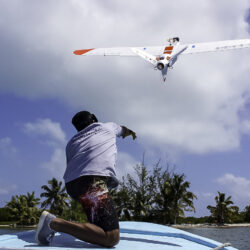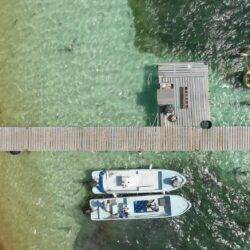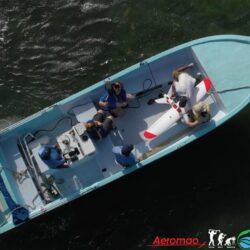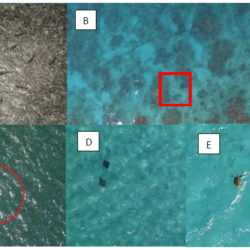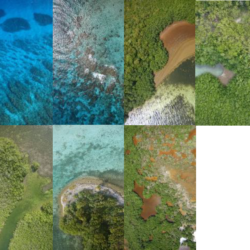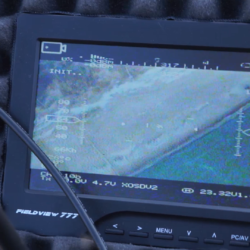Drones for biodiversity protection
Video Produced by: 3WiseMonkeys (https://www.3wm.tv/)
@ThreeWMonkeys
Description
Drones for biodiversity protection
By Melissa Schiele
Amphibious drone tech/Postgraduate research assistant Institute of Zoology Zoological Society of London,
Regent’s Park, London NW1 4RY Email: melissa.schiele@ioz.ac.uk Twitter: @explorer_mel
This article will showcase the latest expedition to the beautiful Turneffe Atoll in Belize with two amphibious Aeromapper Talons built by Canadian company Aeromao with the objective to trial the technology against illegal fishing activities and ecology research toward conservation efforts. The Turneffe marine protected area (MPA) in Belize, was delineated in 2012, but is difficult to manage, in part due to illegal fishing, its remoteness, and high running costs.
We began working with Aeromao in early 2018, when we excitedly commissioned the unknown: a water-landing and waterproof fixed-wing, long range, multi camera UAV, which could be used to monitor and survey marine megafauna (such as turtles, dolphins and sharks) but could also be an effective tool in gathering evidence of illegal, unreported and unregulated fishing (IUU). The reason we had to commission these drones is because, quite simply, nothing else on the market was suitable; quad copters have limited endurance which isn’t suitable for traversing over sea and small islands at great distance, and some of the delta wings and similar units, were unfixable in situ (a seriously important consideration when you’re a remotely based field scientist). Also, nothing on the market had 2 cameras nor was waterproofed. We were asking for an F1 sports car for the price of a jeep. Was it possible? YES! Aeromao delivered, and a R&D partnership was born.
In February 2019 we embarked on our second expedition using the Aeromao Amphibious Talon, the first was held in June 2018 in the British Indian Ocean Territories. Our team and Julian Villada from Aeromao, embarked on a journey which took us to the Caribbean’s barrier reef (the biggest in the western hemisphere). Working with the Turneffe Atoll Sustainability Association’s Conservation officers, we were based on a stunning beach within the headquarters of the organisation.
” The amphibious drone was able to fly to the site of interest at 110m altitude, gather intelligence and fly back very quickly. The images highlighted that indeed illegal building work had been occurring. Without the UAV the conservation officers would have no way of knowing this and they were very excited at this revelation”
The current enforcement strategy on the Turneffe atoll involves patrols in small boats, around the atoll, to find illegal fishers. Systematic surveys for megafauna aren’t regularly carried out, so the conservation officers tend to document animals they happen across on their patrol. However, boat fuel is very costly, and this limits the amount of area the conservation officers can patrol. They were looking for a low-cost, robust technological method to their management issues and the water-landing UAV was the solution.
As part of the flight trials, two of the senior conservation officers were trained on site (who were complete novices in fixed-wing operations) in how to prepare and deploy the drone, how to plan missions and how to monitor flights and ensure a safe water landing. They were amazed at how straight forward the system was and were impressed with the resilience of the polyfoam shell material the drones are made with, pointing out that a carbon shell would be impossible for them to fix, if anything were to go wrong, but foam is easily repaired on the spot; an important consideration given the boat fuel back to the mainland costs around US$200 one way.
Read full technical report here:
The conservation team found the front live-link HD camera an exceptional revelation, especially since they were immediately able to spot a diving boat on the LCD screen, that they could barely see from land. The UAV can fly for up to one and half hours, which, flying at 62kph, is a huge distance and area potentially covered for surveillance- and quickly too.
The pair of drones were also repeatedly operated in BVLOS scenarios. In fact, 24 BVLOS flights were successfully flown during the trials, average length of 10.9km and with total transect lengths of 263km. The UAV reached a furthest point Beyond Visual Line of Sight (BVLOS) of 11.3km. BVLOS was tested in a scenario where the conservation officers particularly wanted to scope out a development site several kilometres away across a large bay in order to detect any infringement of their building contract. The amphibious drone was able to fly to the site of interest at 110m altitude, gather intelligence and fly back very quickly. The images & video recorded highlighted that indeed illegal building work had been occurring. Without the UAV the conservation officers would have no way of knowing this and they were very excited at this revelation “We now have the tool we need to see further and faster than before. No one will see us coming!”, Maurice, a conservation officer reported.
Whilst the UAV flies, the 20mp nadir camera takes 5 images per second, or stunning HD film and the front camera, which can be panned left to right, films and records a live stream, allowing the conservation officers and us, to see what’s out there, in real time, on an LCD screen back at the ground station. Although we tend to fly on pre-designed routes in auto mode, switching to “assisted mode” to investigate something of interest, is no problem. This kind of flexibility means that if we find fishers in the wrong place, we can fly in and get closer pictures of them, or if we see a pod of dolphins, we can zoom in for a closer look and use the images to estimate the numbers of the population in the area. Mapping of habitats, using the nadir camera is also possible and we did map some areas of coral reef and seagrass beds, which can be stitched in Agisoft Metashape or similar software. So really, you could tailor your flights to achieve multiple objectives, saving money and time.
Several static launches of the UAV from a small, moving skiff were successfully performed, which is something that is unheard of for a fixed wing – long range amphibious unmanned aircraft. This is a tremendously important, and previously unknown ability of the UAV, as it now means that the conservation officers can steam to an area where a beach for launching may not exist (very common in mangrove forests), and simply launch from the boat, then land on the water besides the skiff once the mission is completed. This way, no-where the atoll is out of reach for the conservation team.
As marine ecologists, we were equally impressed with the imagery the Amphibious UAV was able to gather. We got extremely clear images of turtles, sharks, eagle rays, manatees and birds and because the drone suffered no ingress of water, it was easy to retrieve the drone from the water, switch over the batteries and fly again, confident in the knowledge that it would perform flawlessly.
“The pair of drones were also repeatedly operated in BVLOS scenarios. In fact, 24 BVLOS flights were successfully flown during the trials, average length of 10.9km and with total transect lengths of 263km. The UAV reached a furthest point Beyond Visual Line of Sight (BVLOS) of 11.3km.”
The UAV’s nadir camera has a 10-degree angle of inclination, which was a feature recommended by the remote sensing team at the Royal Botanical Gardens, Kew, to help with habitat mapping of terrestrial areas. The images were geo-referenced retrospectively, using the image time-stamp and the UAV telemetry log. We were able to capture a variety of habitats, and to identify environmental issues, such as accumulation of plastic debris, and of sargassum seaweed which can cause deoxygenation of the water and block out sunlight.
Geotagging of the images is an essential requirement for IUU surveillance and for ecological surveying, as we need to know exactly where and when something has been detected- it was one of our primary requirements of the UAV system. We can use this data to start to build a spatial picture of how the atoll is used, be it by fishers or fauna, i.e. how the animals use different habitats and when, and when and where fishers are acting with impunity. The results and conclusions can feed directly into planning where marine protected zones are placed. Previously, information on fish abundances would be collected from by-catch on fishing vessels. Since the Turneffe Atoll is a protected area, you can’t rely on catch data anymore- this is where the drones really come into their own as a non-invasive and efficient tool for surveying.
We are very confident as scientists, that having a UAV which can easily land on the ocean, safely, and be flown again in moments, is an exceptionally valuable tool. Likewise, the conservation officers in the Turneffe Atoll are adamant that a UAV like the one we trialled, will become an essential part of their patrolling and enforcement strategy, which will ultimately lead to increased biodiversity in the area.
Read full report here:
Melissa Schiele
Amphibious drone tech/Postgraduate research assistant Institute of Zoology
Zoological Society of London,
Regent’s Park, London NW1 4RY Email: melissa.schiele@ioz.ac.uk Twitter: @explorer_mel
TY – BOOK AU – Schiele, Melissa AU – Letessier, Tom AU – Burke, Claire PY – 2019/05/01 SP – T1 – Amphibious Drone Field Report, Belize. In partnership with the Turneffe Atoll Sustainability Association, Zoological Society of London, the Marine Management Organisation and the Bertarelli Foundation DO – 10.13140/RG.2.2.35265.92004 ER –
About the Aeromapper Talon Amphibious
The Amphibious version of the Aeromapper Talon allows maritime operations by autonomously belly landing on water. It’s the perfect solution for scouting, data collection and mapping thanks to its dual camera set up and long-range video link, up to 2hr endurance and demonstrated BVLOS capabilities up to 30kms from the operators.
The only truly amphibious multipurpose fixed wing drone in the market today, it can sustain repeated operations in salt or fresh water. Perfect for:
- Fisheries
- Marshlands
- Marine research and conservation
- Search and rescue
- Water quality monitoring
- Off-shore infrastructure inspection
- Coastal surveying
- Hydrography
- Marine management
More information: https://aeromao.com/products/aeromapper-talon-amphibious/
Summary
CLIENT: Institute of Zoology Zoological Society of London
LOCATION: Turneffe Atoll in Belize
UAV: Aeromapper Talon Amphibious
